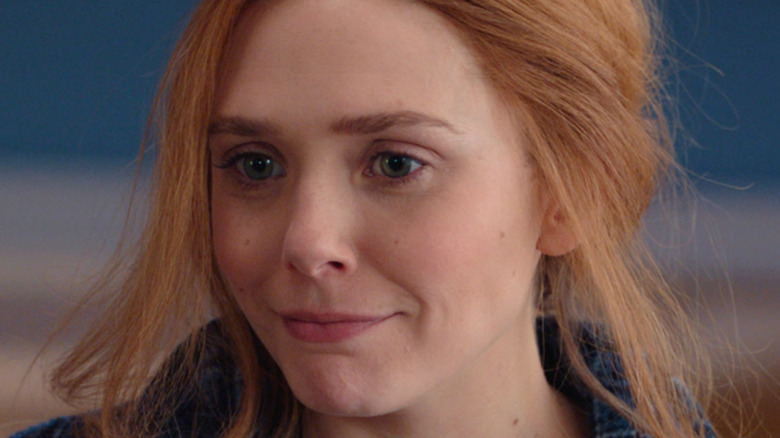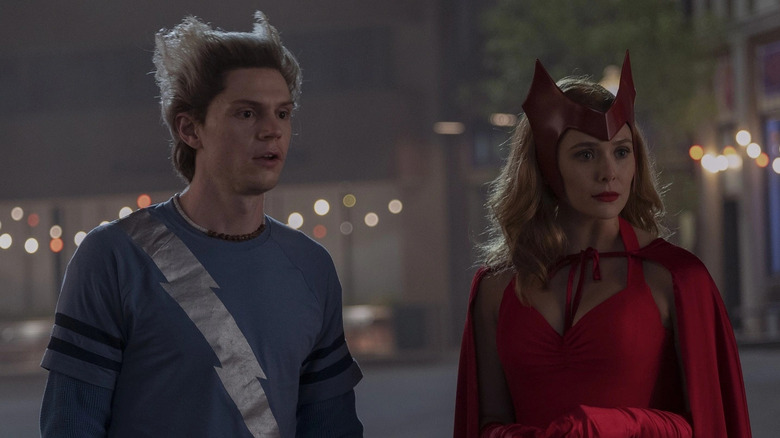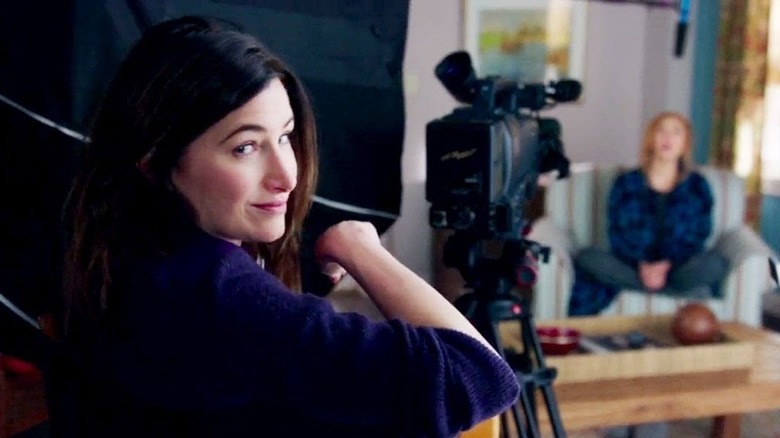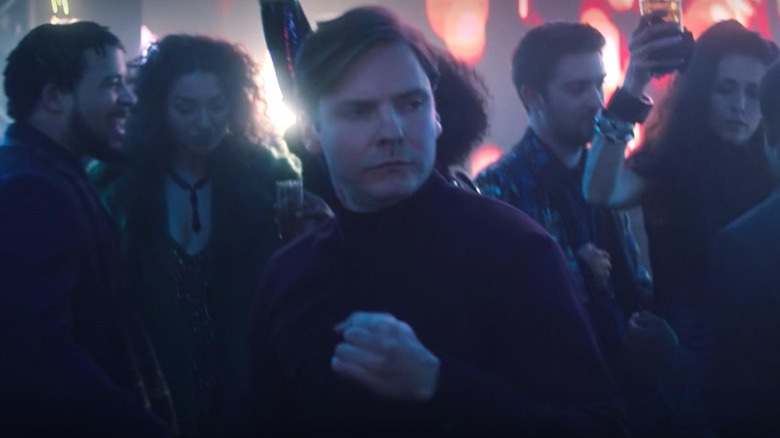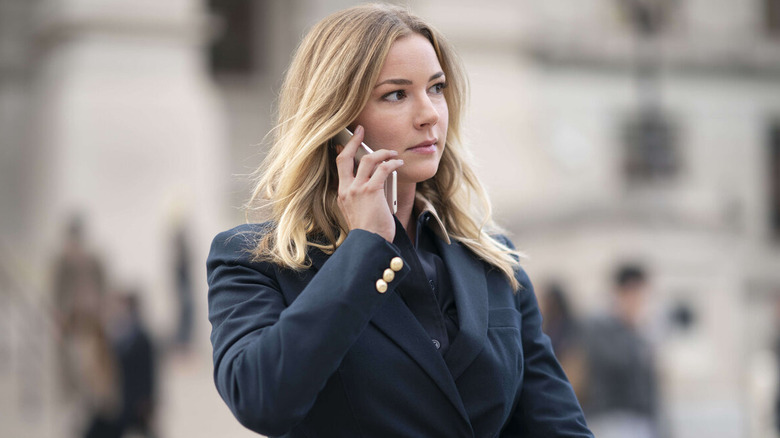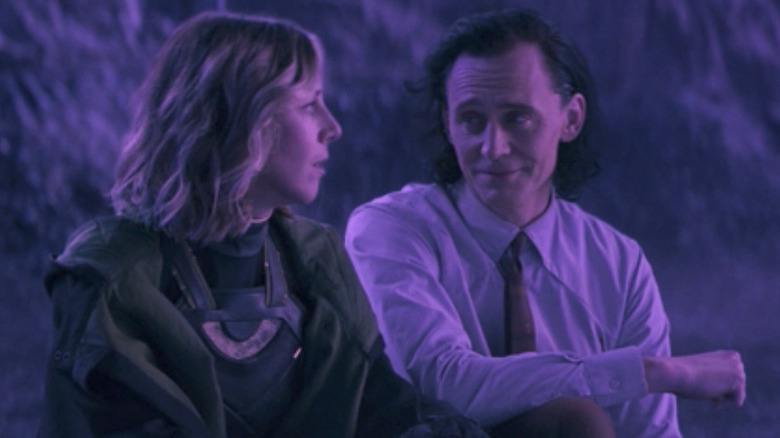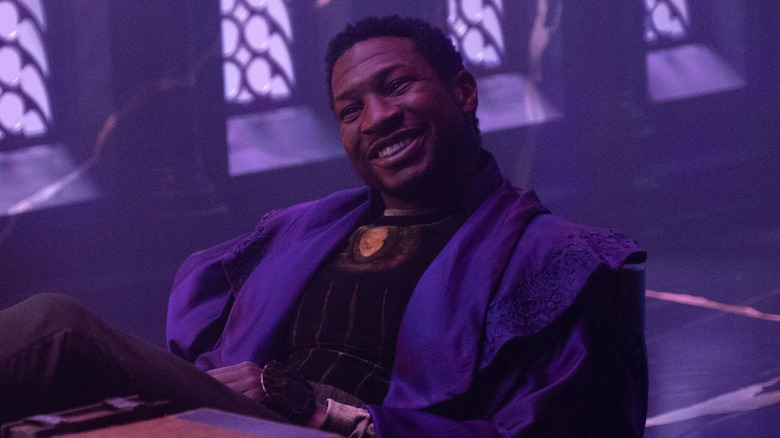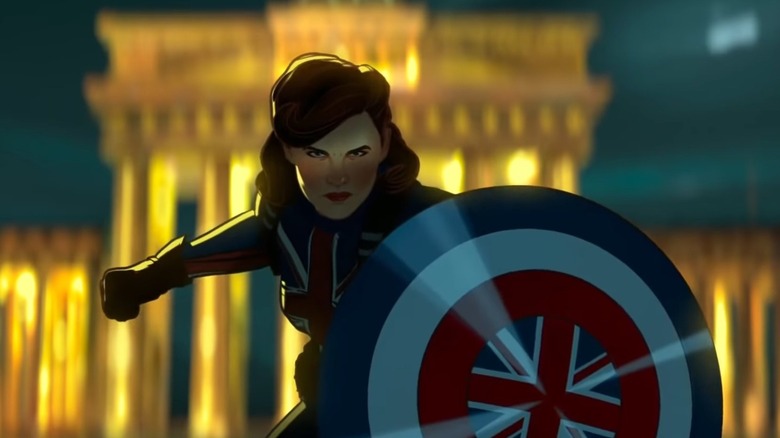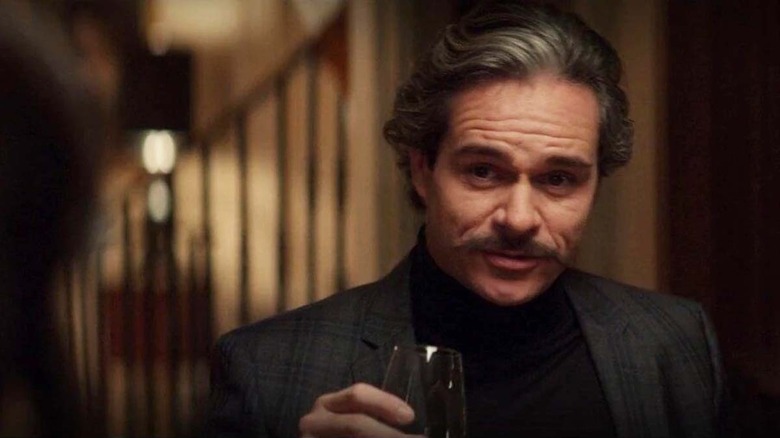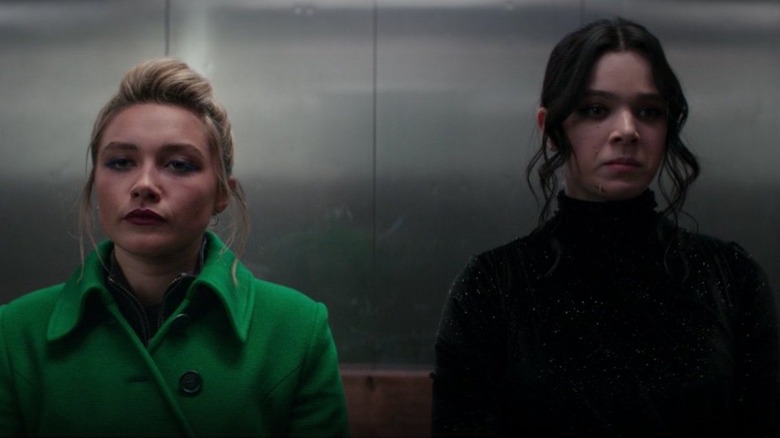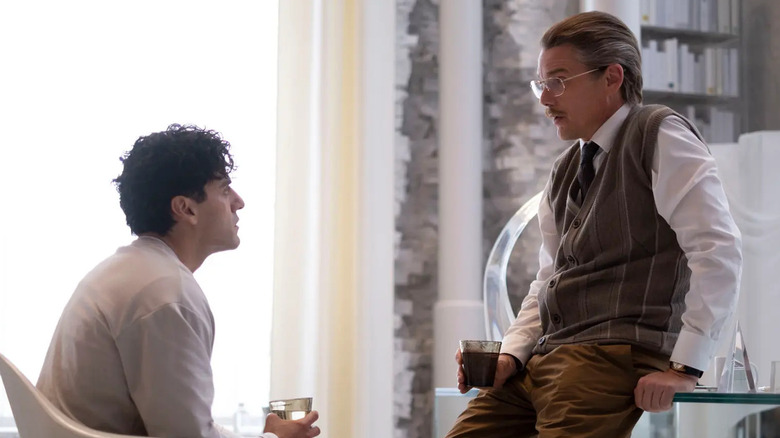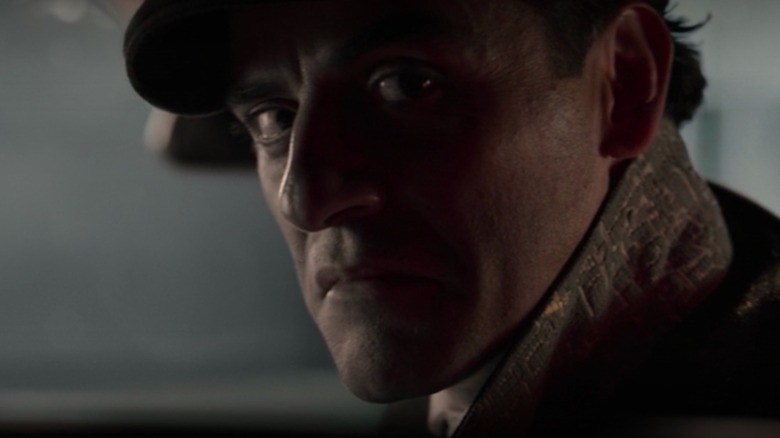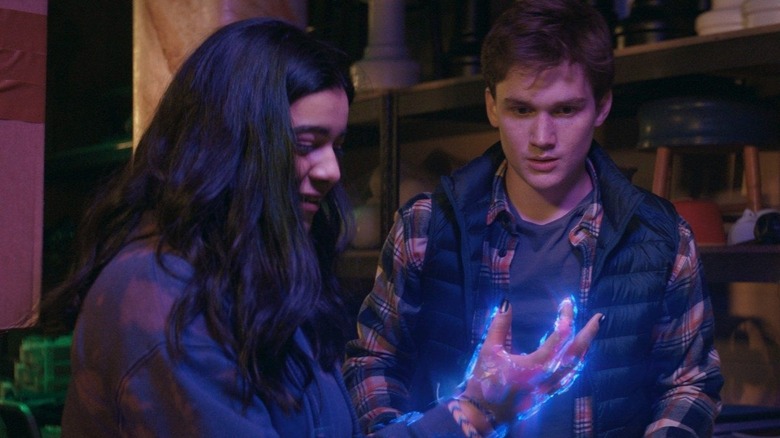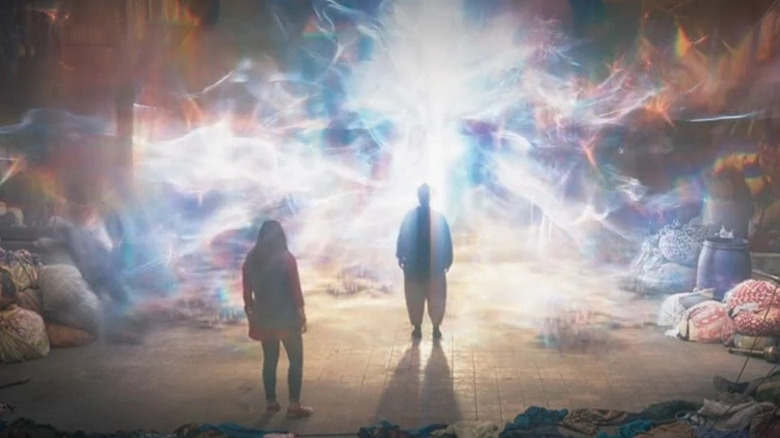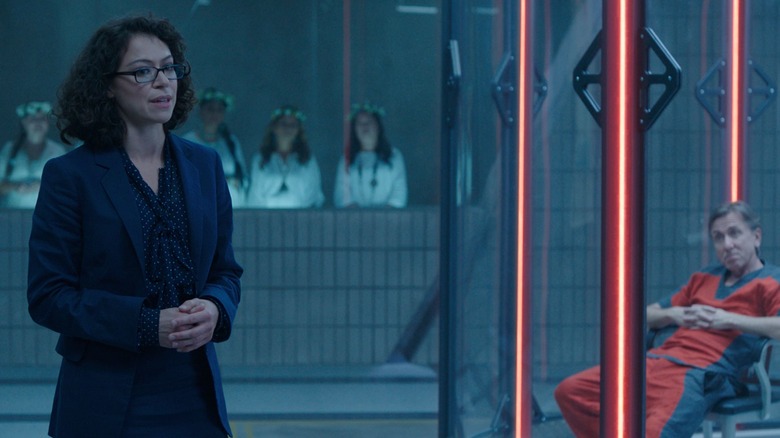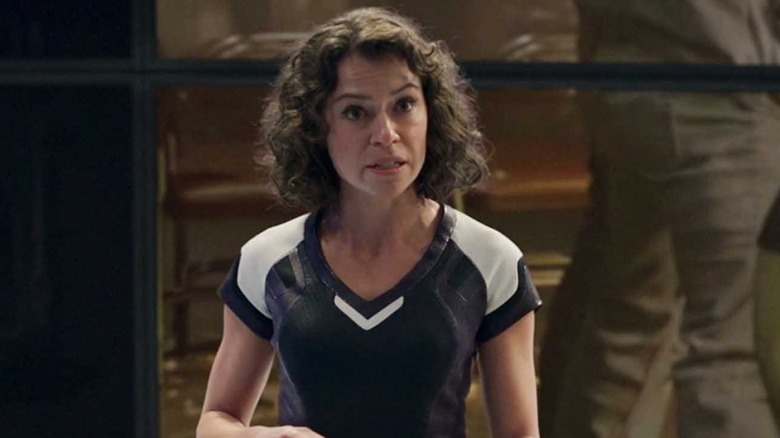The Worst Parts Of The MCU's Phase 4 Shows
Following the release of "The Guardians of the Galaxy Holiday Special" at the end of November, Phase 4 of the Marvel Cinematic Universe has officially come to a close. The phase began at the start of 2021 with "WandaVision," the smash-hit series on Disney+ following the character of Wanda Maximoff after the events of Phase 3's climactic "Avengers: Endgame." However, as the phase continued on with movies and TV series, it has since become one of the most divisive eras in the MCU's history. (Granted, there's only been four eras, so the competition for the "most divisive" award is basically just a contest between Phase 4 and Phase 2.)
With the addition of Disney+ series, showrunners and directors had the opportunity to take more creative dives within the confines of the MCU's traditional formula. Some of these series, like "WandaVision" for example, serve as set-ups for projects to come after, like Wanda's antagonistic role in "Doctor Strange in the Multiverse of Madness," or Monica Rambeau's upcoming appearance in the Brie Larson-helmed movie "The Marvels." However, this creativity and uniqueness didn't always work for fans and critics, resulting in some of the harshest reviews the MCU has had to date. (And the harshest ever ... if you don't count "Iron Man 2" "Thor: The Dark World," "Avengers 2: Age of Ultron," or the Jeph Loeb era of Marvel Television.)
Nevertheless, there's lots to love about each new installment in the Marvel Cinematic Universe, but like all things they're far from perfect. Out of the eight shows that premiered on Disney+ across 2021 and 2022, these 15 storylines contained aspects that rubbed some viewers the wrong way. For others, however, they may have been the highlights of each project.
The return of Pietro Maximoff
"WandaVision" certainly has one of the most original premises across the Marvel Cinematic Universe. Haunted by the death of Vision during "Avengers: Infinity War," Wanda Maximoff starts the series controlling the reality of a small town in New Jersey, forcing its citizens to act as literal extras in her fantasies of being a sitcom married couple with the resurrected Vision. The show ventures through several eras of sitcoms, from the studio audiences of the 1950s to the mockumentary-style productions of the 2000s.
One of the more surprising twists comes at the end of Episode 5, where an argument between Wanda and Vision regarding her control over Westview is interrupted by the arrival of her dead brother, Pietro. Only instead of Aaron Taylor-Johnson reprising his role from "Avengers: Age of Ultron," Pietro is played by Evan Peters, who played Quicksilver in Fox's "X-Men" movies. Almost immediately, fans anticipated this in-universe recasting as evidence that the events of "WandaVision" were going to break open the multiverse (via Vox).
Sadly, this did not come to pass, and what did underwhelmed inflated expectations. As it turns out, Peters' character isn't Pietro — he's an actor with the unfortunate name "Ralph Bohner." Agatha Harkness began mind-controlling Ralph to force Wanda to question her own false reality. While fans were disappointed by Pietro not being the actual Pietro, it was an amusing twist in the eyes of Evan Peters himself.
It was Agatha all along ... right?
Since "WandaVision" was the first MCU installment to air over the course of several weeks, fans could conjure up their theories about where it was going throughout its run. Just about anyone who was on social media in early 2021 will recall some of the more outlandish guesses at the truth of Wanda's situation. People thought Westview was populated by mutants; they figured Monica's engineer friend would turn out to be Reed Richards; they predicted Doctor Strange would intervene, and the list goes on. However, one theory took prevalence as the series went on, and what some viewers interpreted as Easter eggs seemed to indicate it was correct.
The theory revolved around Mephisto — who's basically the Marvel Comics equivalent of the Christian devil. Many fans bought into the notion that prior to the first episode of "WandaVision," Wanda somehow got in contact with the demon who created the Hex for her without letting her know he was torturing the citizens of Westview in the process.
However, the real solution turns out to be much simpler: Wanda's neighbor Agnes was Agatha Harkness, a witch desperate to learn how Wanda got her powers. Agatha was working behind the scenes the whole time, prompting a Billboard-charting musical number. Despite perceived hints towards Mephisto with the commercials of "WandaVision" and the presence of the Darkhold, he's not actually in the show.
Baron Zemo's morality shift
Compared to "WandaVision," "The Falcon and the Winter Soldier" feels like more familiar MCU faire, with a spy-thriller spirit that's pretty similar to the films "Captain America: The Winter Soldier" and "Black Widow." The series follows Sam Wilson and Bucky Barnes as they team up to stop a group of terrorists known as the Flag Smashers. The job eventually forces them to recruit Baron Zemo. In "Captain America: Civil War," Daniel Brühl's character notably frames Bucky for a terrorist attack in order to incite infighting within the Avengers.
It's tricky enough for Sam and Bucky to break Zemo out of prison so he can help them outsmart the Flag Smashers. Fortunately, Zemo proves useful with his connections in Madripoor, a city defined by its criminal underworld. This temporary alliance also gives Zemo the opportunity to achieve his ultimate purpose — ridding the world of super soldiers by taking out the Flag Smashers. Nevertheless, when the Dora Milaje arrive from Wakanda to seize Zemo, the mastermind escapes through a secret tunnel.
Zemo's presence in the series alludes to greater, ulterior motives of his that Bucky and Sam are unaware of. Though he dons his purple mask from the comics for a brief moment, these allusions don't amount to much. Bucky later finds Zemo paying respects at a Sokovian memorial where he turns himself in to the Dora Milaje to resume his sentence. It's quite an underwhelming, passive ending for a character who seems to know more than he lets on.
The face behind the Power Broker
Of course, Baron Zemo is not the only underlying threat to Sam and Bucky's mission throughout "The Falcon and the Winter Soldier." During their investigations in Madripoor, they become aware of a secretive Power Broker who runs the city. Fortunately, they find themselves an ally in Sharon Carter, a former SHIELD agent who helps Steve Rogers during the events of "Captain America: Civil War," which prompts her to become a fugitive from the U.S. government.
By the time Sharon turns up in "The Falcon and the Winter Soldier," she's been living in Madripoor after Thanos' snap apparently removes her from existence for five years — a circumstance the show's titular heroes can easily relate to. She helps Bucky and Sam in their goal to take down the Flag Smashers, though she doesn't disappear from the series yet. In a twist some viewers saw coming, Sharon is the Power Broker, having laid low during the Snap while everyone believed she was dead in order to build up wealth and power in a foreign country.
After killing Karli Morgenthau for betraying their original cause, Sharon is pardoned by the United States. However, according to the post-credits scene of "The Falcon and the Winter Soldier," now that Sharon is taking a position in the CIA, she plans on continuing her business practices as the malicious Power Broker. The twist sets Sharon up for some future conflicts but is overall not a highlight of the series.
Loki falls for himself
"Loki" was a unique experiment for the Marvel Cinematic Universe, especially considering that Tom Hiddleston's character is tragically killed at the start of "Avengers: Infinity War." Nevertheless, the time travel antics on display in "Avengers: Endgame" result in a version of Loki from 2012 getting his hands on the Tesseract, which he uses to teleport out of custody. In the first episode of "Loki," this variant is quickly detained by the Time Variance Authority, whose job it is to maintain the singular timeline of the Marvel Universe.
Eventually, Loki's time with the TVA puts him at odds with ... himself? While hunting a mysterious time criminal female variant of himself named Sylvie, Loki ends up alone with her on the collapsing moon Lamentis-1. The two reluctantly work together to get off the planet where they bond over their different experiences as the same person. Naturally, Loki ends up really growing to care for Sylvie, which Mobius later points out is "pure chaos."
Not every "Loki" viewer was on board with the decision to play out Loki and Sylvie's connection as a love story, which showrunner Michael Waldron explained was meant as a metaphor for self-acceptance (via Marvel). It reaches a breaking out with the Season 1 finale when Sylvie plants a kiss on Loki, only for her to push him through a time door so she can kill her true enemy. The question is ... who is that true enemy, really?
A Big Bad reveal at the end of time
Most of the conflict throughout "Loki" finds our anti-heroes investigating the mystery of the Time-Keepers. Loki and Sylvie eventually confront the mystical beings ... only to discover they're all robots. After Loki and Sylvie both get pruned, they end up in the Void — a dimension where pruned objects and beings reside. Loki and Sylvie reunite in the Void and run into several other variants of themselves.
In the Void, the Lokis confront Alioth — a monster guarding the Citadel at the End of Time — and defeat it. After "WandaVision" and "The Falcon and the Winter Soldier" arguably didn't live up to fan expectations with their surprise Big Bad, "Loki" delivers; Jonathan Majors makes his debut as He Who Remains, the creator of the TVA. As he explains his origins, it becomes clear that He Who Remains is a variant of the villain Kang the Conqueror, who crosses multiverses to wage war against himself.
Unfortunately, the real finale of "Loki" will have to wait. The series ends on a cliffhanger as Sylvie kills He Who Remains, breaking open the multiverse and unleashing an infinite number of Kangs. Loki himself ends up in an alternate TVA with a Mobius who doesn't remember him. With the confirmation that "Loki" Season 2 will eventually premiere, hopefully the season will retrospectively be more than just set-up for future MCU projects.
A rerun of Captain America: The First Avenger
After "Loki" breaks open the multiverse of the Marvel Cinematic Universe, the next series to hit Disney+ was the animated anthology "What If... ?" Based on the comic book series of the same name, the first season takes a look at several alternate timelines and features the voices of returning cast members. Some examples include Doctor Strange going evil after the death of Christine Palmer and Killmonger rescuing Tony Stark in Afghanistan. The first episode, however, treads a lot of familiar territory for Marvel fans.
Titled "What If... Captain Carter Were the First Avenger?" the episode centers on Peggy Carter, the SHIELD co-founder whose flirtation with Steve Rogers during World War II is cut short. Though the two get their happy ending in "Avengers: Endgame," this episode examines an alternate path where Peggy steps in for a wounded Steve and takes the coveted super soldier serum. As a result, she becomes Captain Carter, a Union Jack-brandishing superhero, while Steve ends up piloting the HYDRA Stomper.
As a result of this near miss, the beats of this "What If... ?" episode reenact many scenes from "Captain America: The First Avenger," including many of the episode's action sequences. Some reviewers felt the episode lacked the imagination promised by "What If... ?" as a concept, although later episodes probably came closer to fulfilling audience expectations. But for a debut episode, Captain Carter isn't the most interesting alternate timeline that they could've explored.
The hidden agenda of a suspicious swordsman ... or lack thereof
Despite being the first MCU project to star Jeremy Renner's hardened Avenger Clint Barton, a considerable portion of the series focuses on a brand-new character. Hailee Steinfeld debuts as Kate Bishop — a college-aged archer who's admired Barton ever since the Battle of New York in 2012. However, when she ends up the target of the Tracksuit Mafia for stealing Clint's old Ronin costume, she finally meets her hero and they work together to clear her name and investigate the criminal organization.
As if that isn't enough, Kate also grows suspicious of her mother's new fiancé, Jack Duquesne. Played by "Better Call Saul" standout Tony Dalton, the sword connoisseur has evil mastermind written all over him, especially when Jack's uncle Armand is found murdered by a sword wound. Given that Kate spots Armand threatening Jack at a black-market auction during the first episode of "Hawkeye," it seems clear he has a bigger agenda.
To the chagrin of old-school Swordsman fans, Jack has no hidden agenda at all — he just likes swords. His presence at the auction is due to his interest in purchasing Ronin's sword, and his connections to the Tracksuit Mafia are illegitimate. He is briefly framed for Armand's murder by Kate's mother, who is an employee of Wilson Fisk. He even helps Kate and Clint fight the Tracksuits during the series finale. Nevertheless, Jack's suspicious behavior was just a red herring.
Yelena targets Clint Barton
Florence Pugh easily became a fan favorite of MCU fans with her role as Yelena, the adopted sister of Natasha Romanoff, in 2021's "Black Widow." The post-credits scene of that film teases Yelena's return in "Hawkeye," when Julia Louis-Dreyfus' mysterious government agent, Valentina Allegra de Fontaine, tasks Yelena with assassinating Natasha's killer — Clint Barton. Of course, fans know Hawkeye didn't kill Black Widow — Natasha sacrifices herself on Vormir in "Avengers: Endgame" so the good guys can save half of humanity.
Though this motivation seems simple enough, "Hawkeye" makes it needlessly complicated. Yelena finally shows up in the series' fourth episode to ambush Clint and Kate. In the next episode, Yelena visits Kate and reveals her identity as Natasha's sister and that she's been hired to kill Clint. After Kate asks who hired Yelena, Yelena does some snooping and reveals that the person who hired her was none other than Kate's mom, Eleanor.
It raises several questions how Eleanor is connected to Valentina, but what's even more confusing is when Yelena decides to continue her mission of killing Clint in the finale, despite Kate's attempts to stop her. Nevertheless, Clint gets an opportunity to talk to Yelena, convincing her that Natasha sacrificed herself and that he tried to stop her. Though it's an emotional moment for the two characters to share, it's not the most natural escalation of plot in the series (via The Wrap).
Inside the mental asylum of Marc Spector's mind
Next to the likes of Spider-Man and Captain America, Moon Knight is a comparatively obscure character, which made it pretty ambitious for Marvel to make him the focus of a Disney+ series.
Oscar Isaac stars as Steven Grant, a mild-mannered British museum employee who discovers he's the dissociative identity of an American ex-Marine named Marc Spector who serves the Egyptian god Khonshu as the hero Moon Knight. Quickly, Steven and Marc get caught up with a mysterious cult led by Ethan Hawke's Arthur Harrow as they fight for control over the same body.
"Moon Knight" was acclaimed by critics for its exploration of mental illness, specifically dissociative identity disorder. Because of this, the show is much more psychedelic than most other MCU projects, as Oscar Isaac spends most of the series acting against himself in a mirror. "Moon Knight" goes even further in Episode 4, when Marc is seemingly killed and wakes in a mental asylum where he's a patient getting interviewed by a psychologist who bears a striking resemblance to Hawke's character.
While Episode 5 reveals a lot of backstory about Marc, it does so through this mental asylum framework that, frankly, only gets more confusing (via Polygon). As Marc and Steven navigate this mental asylum-shaped afterlife, the series cuts back and forth to these interviews with Dr. Harrow, which apparently take place inside Marc's mind. The interviews continue throughout the finale, interrupting Marc and Steven as they finally start working together against Harrow.
Marc, Steven, and a third voice
For several episodes of "Moon Knight" leading up to the finale, fans noticed clues and Easter eggs that suggest there may be more personalities inside the body of Marc Spector than Steven Grant. In Episode 3, Marc consistently loses consciousness during a fight, which he blames on Steven, who denies his involvement. Later, during Episode 4's first foray in the dream-like mental asylum, Marc and Steven pass by a room with a sarcophagus violently shaking.
Comic book fans in particular anxiously awaited the reveal of Jake Lockley. In the comics, Lockley is a cab driving persona of Marc, and more of a street-level fighter. However, during the final battle, "Moon Knight" opts to repeat its earlier beat of Marc losing consciousness during a fight with Arthur Harrow and coming back to consciousness after nearly killing Harrow. Still, the reveal is left unrevealed ... until the first season's post-credits scene.
In the very last moments of the "Moon Knight" finale, a mysterious stranger checks Arthur Harrow out of a real mental asylum, bringing him into a limo where Khonshu sits. There, Khonshu introduces Harrow to his driver, Jake Lockley — another personality of Marc and Steven sporting a cap and a Spanish accent. Lockley shoots Harrow with a silenced pistol, indicating that he's clearly a more devoted follower of Khonshu. Unfortunately for some fans, this reveal of Lockley was too little and too late, and only serves as a set-up for Moon Knight's next adventure.
Ms. Marvel strays from her comic book counterpart
After "Moon Knight" kickstarted the Marvel Cinematic Universe in 2022, "Ms. Marvel" was a departure in terms of tone. The series follows Kamala Khan, a Pakistani teenager who lives in Jersey City, who spends her free time idolizing the Avengers — particularly Carol Danvers. Her life is frustratingly normal, until one night she sneaks out to compete in a Captain Marvel cosplay contest. To add to her costume, she borrows an ancient family bangle which imbues her with the ability to control energy.
While "Ms. Marvel" was a recipient of a lot of unearned criticism, her powers in the series were subject to complaints from die-hard comic book fans who claimed to be frustrated with the massive change from the comics. In the comics, Kamala is exposed to the Terrigen Mist, which activates her Inhuman ability to change the size and shape of her limbs, similar to Mr. Fantastic. Nevertheless, the minds behind the "Ms. Marvel" series made her powers more similar to DC's Green Lantern in an attempt to connect her to the existing MCU, as well as Carol Danvers herself (via Entertainment Weekly). (And maybe to avoid eating Reed Richards' metaphorical lunch before he arrives in the MCU himself in a couple of years.)
It's clear from the beginning of "Ms. Marvel" that this version of Kamala isn't an Inhuman like her comics counterpart. Considering the baggage associated with Inhumans in the MCU, making this change was probably a wise decision. The end of the show hints that Kamala might be a mutant, and if that turns out to be the case, it could completely change the nature of her origin and perhaps lead to an association with the X-Men in future stories.
The threat of the Clandestines
As one might expect from a superhero series, Kamala's acquisition of powers comes with some bonuses. Just as she's learning how to become a superhero, Kamala sparks up a flirtation with Kamran, the handsome new kid at her school. However, there are consequences to Kamala's new life as well; Kamran's mother turns out to be Najma, the leader of a group of Djinns who call themselves the Clandestines. Having been exiled from their home in the Noor dimension, they've been trying to get back for centuries.
Fortunately for them, Kamala's new powers are exactly what they need. They sweeten the pot for her by telling Kamala that her great-grandmother Aisha was also a Clandestine, though Kamala is hesitant to dip her feet into interdimensional travel. The Clandestines follow Kamala to Karachi, where they ambush her and force her to open a gate to the Noor dimension in Episode 5. However, the gate automatically vaporizes anyone who comes in contact with it, forcing Najma to sacrifice herself to close it.
Ultimately, the Clandestines prove to be pretty underwhelming villains for Kamala. Their deaths eliminate them as antagonists for the series' finale, which focuses on Kamala escaping capture from the United States Department of Damage Control. In addition, their heel turn towards Kamala was seen by many as too quick, and ultimately, as threats to her growth as a superhero, they're a little bland.
Jen tries to help Emil Blonsky
"She-Hulk: Attorney at Law" was quite the divisive TV series, even by MCU standards. The series stars Tatiana Maslany as Jennifer Walters, the cousin of Mark Ruffalo's Bruce Banner. After a car accident and a resulting close encounter with her cousin's gamma-radiated blood, Jen becomes capable of transforming into She-Hulk. For a career lawyer with a lot of promise, these abilities are mostly a liability until she gets the opportunity to represent superhumans at a prestigious law firm.
In the first primary story arc of the show, Jen represents Emil Blonsky, the former rival of Bruce Banner who can turn into the Abomination. Jen represents the former British Marine in his parole hearing, and she kind of coasts through this part of the show. She takes the assignment under threat of firing from her boss, Emil briefly breaks out to spar with Wong (as seen in "Shang-Chi and the Legend of the Ten Rings,") and then the hearing is derailed when Emil frightens the parole board by transforming. Granted, Jen's speech to the board — pointing out that they plainly just saw Emil transform without losing control, which means he's no longer dangerous — is what convinces them to grant his parole, but talking her way out of the situation doesn't exactly scream "badass." We know "She-Hulk" is supposed to be a funny lawyer show, and lawyering usually entails a lot of talking, but still.
Breaking the fourth wall
If "She-Hulk: Attorney at Law" is divisive throughout its run, the first season's finale leans all the way into giving half the fans exactly what they want and leaving the other half confused and-slash-or annoyed. As the final episode grows increasingly chaotic and nonsensical, Jen breaks the fourth wall and demands a better finale. She then does what no other Marvel character, not even Deadpool, has done — she leaves the show. Literally, Jen climbs out of the Disney+ home page and heads to Marvel Studios to confront Kevin Feige.
After a brief stop at the writers' room, Jen fights her way into the office of Kevin Feige, only to find K.E.V.I.N., an A.I. who runs all of Marvel Studios. After shifting back into her human form to save on the CGI budget, Jen demands that her storyline be rewritten, and K.E.V.I.N. obliges. Throughout this sequence, she also makes reference to several other MCU films and characters, and even asks when the X-Men are going to appear in the MCU. For diehard MCU fans, it's quite a meta, "Rick & Morty"-style moment.
Some critics took issue with this part of the story, while others thought it was by far the best season finale a Disney+ MCU show has had thus far. Of course, the whole joke of the "She-Hulk" finale is MCU Disney+ shows have been kind of bad at doing season finales so far, so it's not as if "She-Hulk" had to clear a high bar on that one.
